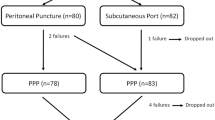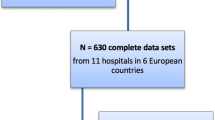Abstract
Introduction
The surgical treatment of large incisional hernias with loss of domain (LIHLD) carries the risk of fascia closure under tension and, thus, abdominal compartment syndrome. We investigated volume measurements as a predictive factor for tension-free fascia closure.
Patients and methods
From September 2004 to July 2008, we prospectively included 17 patients with LIHLD. The operation was prepared by a progressive preoperative pneumoperitoneum (PPP) technique known as the Goni Moreno procedure. The patient’s age and body mass index (BMI), the incisional hernia’s width, length and surface area, and the incisional hernia volume (IHV)/peritoneal volume (PV) ratio <20% were evaluated as predictive factors for tension-free fascia closure. A tension-free closure was defined as a closure in which the use of a surgical device for avoiding postoperative compartment syndrome was not required.
Results
The mean PPP volume introduced was 12.7 ± 4.4 l (range 4.5–19.2) over a period of 11 ± 6 days (range 4–24). The mean width, height and surface area of the incisional hernia after PPP were 11.3 ± 4.7 cm (range 4.5–19), 13.4 ± 7.8 cm (range 4.4–30) and 165 ± 101 cm2 (range 19–304), respectively. The mean IHV after PPP was 2,374 ± 1,356 cc (range 517–4,802) and the mean abdominal cavity volume was 9,558 ± 4,106 cc (range 4,785–21,782). The mean IHV/PV ratio was 16.3 ± 10.4% (range 4.4–34). In a univariate analysis, the BMI and the IHV/PV ratio were predictive of tension-free fascia closure. In a multivariate analysis, only an IHV/PV ratio <20% was a significant predictive factor.
Conclusions
The IHV/PV ratio is predictive of tension-free fascia closure for hernias or incisional hernias with loss of domain. Simplification of the volumetry method is necessary.



Similar content being viewed by others
References
Korenkov M, Paul A, Sauerland S, Neugebauer E, Arndt M, Chevrel JP, Corcione F, Fingerhut A, Flament JB, Kux M, Matzinger A, Myrvold HE, Rath AM, Simmermacher RK (2001) Classification and surgical treatment of incisional hernia. Results of an experts’ meeting. Langenbecks Arch Surg 386:65–73
Chevrel JP, Caix M (1987) Surgery of the abdominal wall. Springer, Berlin Heidelberg
Stoppa R, Ralaimiaramanana F, Henry X, Verhaeghe P (1999) Evolution of large ventral incisional hernia repair. The French contribution to a difficult problem. Hernia 3:1–3
Lowe JB 3rd, Lowe JB, Baty JD, Garza JR (2003) Risks associated with “components separation” for closure of complex abdominal wall defects. Plast Reconstr Surg 111:1276–1283
Berlemont M (1952) Pneumoperitoneum as a cure for enormous irreducible hernias. Mem Acad Chir (Paris) 78:77–78
La Meir M, Vierendeels T, Poortmans M (2002) Pneumoperitoneum in repair of giant hernias and eventrations. Acta Chir Belg 102:263–265
Paajanen H, Laine H (2005) Operative treatment of massive ventral hernia using polypropylene mesh: a challenge for surgeon and anesthesiologist. Hernia 9:62–67
Dumont F, Fuks D, Verhaeghe P, Brehant O, Sabbagh C, Riboulot M, Yzet T, Regimbeau JM (2009) Progressive pneumoperitoneum increases the length of abdominal muscles. Hernia 13:183–187
Goñi Moreno I (1971) Pneumoperitoneum applied to the surgical preparation of large chronic eventrations. Prensa Med Argent 58:1037–1041
Toniato A, Pagetta C, Bernante P, Piotto A, Pelizzo MR (2002) Incisional hernia treatment with progressive pneumoperitoneum and retromuscular prosthetic hernioplasty. Langenbecks Arch Surg 387:246–248
Mayagoitia JC, Suárez D, Arenas JC, Díaz de León V (2006) Preoperative progressive pneumoperitoneum in patients with abdominal-wall hernias. Hernia 10:213–217
Kingsnorth AN, Sivarajasingham N, Wong S, Butler M (2004) Open mesh repair of incisional hernias with significant loss of domain. Ann R Coll Surg Engl 86:363–366
Sabbagh C, Dumont F, Fuks D, Yzet T, Verhaeghe P, Regimbeau JM (2011) Progressive preoperative pneumoperitoneum preparation (the Goni Moreno protocol) prior to large incisional hernia surgery: volumetric, respiratory and clinical impacts. A prospective study. Hernia (under review)
Wigmore SJ, Redhead DN, Yan XJ, Casey J, Madhavan K, Dejong CH, Currie EJ, Garden OJ (2001) Virtual hepatic resection using three-dimensional reconstruction of helical computed tomography angioportograms. Ann Surg 233:221–226
Farges O, Belghiti J, Kianmanesh R, Regimbeau JM, Santoro R, Vilgrain V, Denys A, Sauvanet A (2003) Portal vein embolization before right hepatectomy: prospective clinical trial. Ann Surg 237:208–217
Malbrain ML, Cheatham ML, Kirkpatrick A, Sugrue M, Parr M, De Waele J, Balogh Z, Leppäniemi A, Olvera C, Ivatury R, D’Amours S, Wendon J, Hillman K, Johansson K, Kolkman K, Wilmer A (2006) Results from the International Conference of Experts on Intra-abdominal Hypertension and Abdominal Compartment Syndrome. I. Definitions. Intensive Care Med 32:1722–1732
Tanaka EY, Yoo JH, Rodrigues AJ Jr, Utiyama EM, Birolini D, Rasslan S (2010) A computerized tomography scan method for calculating the hernia sac and abdominal cavity volume in complex large incisional hernia with loss of domain. Hernia 14:63–69
Raynor RW, Del Guercio LR (1989) The place for pneumoperitoneum in the repair of massive hernia. World J Surg 13:581–585
Coelho JC, Brenner AS, Freitas AT, Campos AC, Wiederkehr JC (1993) Progressive preoperative pneumoperitoneum in the repair of large abdominal hernias. Eur J Surg 159:339–341
Barbosa MV, Nahas FX, Garcia EB, Ayaviri NA, Juliano Y, Ferreira LM (2007) Use of the anterior rectus sheath for abdominal wall reconstruction: a study in cadavers. Scand J Plast Reconstr Surg Hand Surg 41:273–277
Ramirez OM, Ruas E, Dellon AL (1990) “Components separation” method for closure of abdominal-wall defects: an anatomic and clinical study. Plast Reconstr Surg 86:519–526
Daigeler A, Fansa H, Altmann S, Awiszus F, Schneider W (2004) Abdominal wall reconstruction with pedicled rectus femoris muscle flap. Chirurg 75:609–614
Lipman J, Medalie D, Rosen MJ (2008) Staged repair of massive incisional hernias with loss of abdominal domain: a novel approach. Am J Surg 195:84–88
Chevrel JP, Rath AM (2000) Classification of incisional hernias of the abdominal wall. Hernia 4:7–11
Langer C, Schaper A, Liersch T, Kulle B, Flosman M, Füzesi L, Becker H (2005) Prognosis factors in incisional hernia surgery: 25 years of experience. Hernia 9:16–21
Ammaturo C, Bassi G (2005) The ratio between anterior abdominal wall surface/wall defect surface: a new parameter to classify abdominal incisional hernias. Hernia 9:316–321
Ching SS, Sarela AI, Dexter SP, Hayden JD, McMahon MJ (2008) Comparison of early outcomes for laparoscopic ventral hernia repair between nonobese and morbidly obese patient populations. Surg Endosc 22:2244–2250
Moore M, Bax T, MacFarlane M, McNevin MS (2008) Outcomes of the fascial component separation technique with synthetic mesh reinforcement for repair of complex ventral incisional hernias in the morbidly obese. Am J Surg 195:575–579; discussion 579
Chang EI, Foster RD, Hansen SL, Jazayeri L, Patti MG (2007) Autologous tissue reconstruction of ventral hernias in morbidly obese patients. Arch Surg 142:746–749
Author information
Authors and Affiliations
Corresponding author
Rights and permissions
About this article
Cite this article
Sabbagh, C., Dumont, F., Robert, B. et al. Peritoneal volume is predictive of tension-free fascia closure of large incisional hernias with loss of domain: a prospective study. Hernia 15, 559–565 (2011). https://doi.org/10.1007/s10029-011-0832-y
Received:
Accepted:
Published:
Issue Date:
DOI: https://doi.org/10.1007/s10029-011-0832-y




